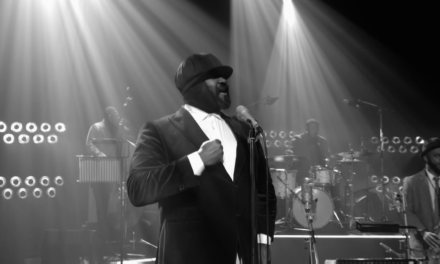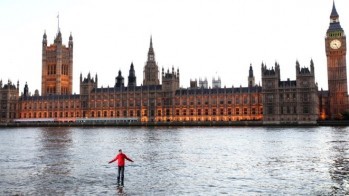Laura Mulvey’s “Visual Pleasure and Narrative Cinema” is the gift that enigmatically keeps on giving. An avowed overstatement for polemical purposes, Mulvey’s essay, as she had hoped, was and remains a springboard for discussing sexism in the media. Recently, because of the Amazon series The Marvelous Mrs. Maisel, I returned to it with renewed curiosity and a specific interest in her identification of a particular tendency in Hollywood to use women’s glamorized bodies for objectification while barring us from the plot action. As you will remember, Mulvey discussed the way in (O so many) movies the female star is a performer but not an actor, a gendered distinction, meaning the leading female character is a singer or other entertainer peripheral to the action, initially appearing onstage in the spotlight as she enchants and bewitches. Never to become crucial to the plot, which is reserved for the male star, she pops up spotlit in scenes that interrupt the male action. Until, that is, she is domesticated by the hero and made his own. Now the woman extracted from the spotlight has lost even the power she once had to distract and is reduced to being a complete adjunct of the male protagonist. It’s a pattern that Marlene Dietrich films perfected and that Mulvey acknowledged to be less than universal, but spotting it has proven useful for feminist analysis of Hollywood’s structurally embedded sexism. It is also useful to push against. This pattern has heuristic value for looking into mass entertainment narratives about aspiring female stars who make the journey, from dowdy non-entities to glamorous captivating spectacles, moving in a reverse Mulvey direction. Sort of, and this will be explained. It is only with The Marvelous Mrs. Maisel (2017), a series created by Amy Sherman-Palladino for Amazon Studios, the latest “reverse Mulvey,” that some really interesting changes are rung on the trope that Dietrich made so kitchily enticing.
 The reverse Mulvey movie has a tradition of its own, prominently featuring the many versions of the A Star is Born story. The most interesting of these from a feminist perspective is its 1954 incarnation in which Judy Garland played Esther Blodgett, a girl lost in the crowd who is reborn as shining star,Vicki Lester. Another crucial reverse Mulvey is Singin’ in the Rain (1952) in which Kathy Selden (Debbie Reynolds), a chorus girl initially indistinguishable from the rest of the line and then hidden behind a curtain as she provides the voice for a vocally untalented star, breaks out into visible fame. In both films, Hollywood classics, the pattern identified by Mulvey is troubled fascinatingly but nevertheless retains its grip on the narrative since both Esther/Vicki and Kathy are relegated to secondary status while the spotlight shines on them.
The reverse Mulvey movie has a tradition of its own, prominently featuring the many versions of the A Star is Born story. The most interesting of these from a feminist perspective is its 1954 incarnation in which Judy Garland played Esther Blodgett, a girl lost in the crowd who is reborn as shining star,Vicki Lester. Another crucial reverse Mulvey is Singin’ in the Rain (1952) in which Kathy Selden (Debbie Reynolds), a chorus girl initially indistinguishable from the rest of the line and then hidden behind a curtain as she provides the voice for a vocally untalented star, breaks out into visible fame. In both films, Hollywood classics, the pattern identified by Mulvey is troubled fascinatingly but nevertheless retains its grip on the narrative since both Esther/Vicki and Kathy are relegated to secondary status while the spotlight shines on them.
In the case of Vicki Lester, when in the final moments of the film she wins an academy award, outwardly clad in the shining glamour of the female performer, she inwardly shrinks into the little woman, by abasing herself utterly to the memory of her deceased husband. “This,” she tells her audience is (not Viki Lester), but “Mrs. Norman Maine.” Similarly, when Kathy Selden is thrust toward glamour and fame at the end of Singin’ in the Rain by the two male stars of the film, Gene Kelly (as matinee idol Don Lockwood) and Donald O’Connor (as the dancing clown Cosmo Brown), it happens in a way that robs her of autonomy and dignity, and perpetuates male control over her. Don and Cosmo make Kathy a laughing stock as they catapult her into the spotlight. Now along comes Mrs. Maisel, a reverse Mulvey with a difference.
Midge Maisel (Rachel Brosnahan) a 1950’s upper west side of New York haus frau at the beginning of the first season, ends the season brilliantly on display as she wows the crowd at the Gaslight Cafe, while her husband, Joel Maisel (Michael Zegen) appears to lose control not only over her but over himself. At the moment Midge makes it as a stand-up comedy star, she controls the spotlight, while her husband is drunkenly and pointlessly getting himself into a fight outside in the gutter with a heckler whom Midge has already put in his place and sent packing. Midge has previously been nameless as an entertainer, but now shining with pride, when she identifies herself for the first time in stand-up, saying ”My name is Mrs. Maisel. Thank you and good night,” she gives new meaning to the phrase, “taking her husband’s name.” It’s hers and barely his. Qué pasa, Mulvey-wise?
It’s only the end of the first season, so in its impending second season that has been commissioned by Amazon there is plenty of time left for a recuperation of Midge’s stardom back to an “appropriate” position in the gender hierarchy. The sign that this is possible is that Midge’s rise is resonant of the zero-sum game in the Star is Born plot. In the clichéd battle of the sexes, for the woman to rise, the man must fall, and the woman pay the price. Midge begins her rise in stand-up just as Joel fails miserably at his attempt to be part of the circle, and we leave her in the season finale when Joel is left with nothing, not even his day job as a once successful business man. Midge may ultimately pay the price, if only to restore balance to this unbalanced situation. In addition, Midge is never dowdy or in her husband’s shadow. From the start she is a fashion icon who turns heads at the butcher shop and in living rooms with her eye catching and expensive wardrobe. Nevertheless, she does make a transition to the public spotlight as the episodes unfold, and there are some interesting gender issues raised as Midge takes centre stage publicly, the most interesting being the centrality of women to Midge’s rise. The reverse Mulvey diva is conventionally the property of industry men who have a major stake in her success. Not so Mrs. Maisel.
The person fighting for Midge’ to win a place at the mic is a very unthreatening, rather sympathetic butch lesbian, Susie Myerson (Alex Borstein) who begins the series signing up acts for the Gaslight. Midge’s ally could easily have been the fictionalized version of Lenny Bruce (Luke Kirby) who graces this series and has frequent, amusing encounters with Midge, or any number of other men. But Lenny and the other men in Midge’s path remain peripheral to the action of Midge’s story. Susie and Midge are not exactly a buddy pair, but Sherman-Palladino’s choice of Susie as Midge’s agent and most crucial professional facilitator makes this a womanized landscape rather than the old sexist narrative of a female who is alone of her sex. Similarly, Midge’s climactic antagonist in her pursuit of social significance as a performer is an already extremely successful woman, a (fictional) iconic female comedian named Sophie Lennon (Jane Lynch), not Lenny, who could easily have been scripted as part of a battle of the sexes. This would have been the traditional choice; and it would have neatly kept Midge in a male arena. But while show biz is clearly the province of men in this series, Sherman-Palladino presents the central events taking place among women. Here women are regularly in the spotlight and don’t stop the action. They are the action. The Bechdel test is vibrating like a David Lynch soundtrack.
Women in the spotlight rarely have women friends in Mulveyan Hollywood, except if they are Eve Arden and serve as a Greekish chorus for the diva and her men. They don’t talk to each other except about men. By contrast, when in a fit of pique, after he fails miserably as a stand-up at the Gaslight open mic, Joel leaves Midge for his secretary, a distraught Midge downs a bottle of booze and in her nightgown and winter coat returns to the scene of her abandonment, the Gaslight. Stumbling onto the stage, without permission, she drunkenly displays both her bare breasts and prodigious stand-up potential–and Suzie sees her chance to rise from booking for a club in the village to being an agent for a major star. Impressively central to the plot are two women making careers for themselves. Impressive too is the way Midge and Susie negotiate the line between professional allies and friends without once pandering either to trendy chic lesbianism or homophobia. Susie’s sex life is her own business; so is Midge’s. With Susie’s assistance, as a stand-up comic, Midge turns the charismatic display historically associated with women away from a static existence as a scopophilic object and into an active plot enterprise. And that’s the point of Midge’s penultimate battle of the first season, with Sophie Lennon, before Midge takes Joel’s name away from him and holds the spotlight.
Against all odds, Susie connects Midge with Harry Drake (David Paymer) the (male) agent of Sophie Lennon, reigning queen of female comics. Scared but feistily testing her agent muscles, Susie manages the situation so that Drake agrees, astonishingly, to put Midge on the bill in front of a tough audience as Sophie’s warm up act, if Sophie agrees. When Midge attends Sophie’s show, in awe of the older woman’s power over an audience, and meets Sophie for the first time for her approval, Sophie stands before us in the form of her comic persona, a fat, coarse, sloppy, working class drudge from Queens. But when Midge sparks Sophie’s interest and is invited to take tea with her at her palatial home, it turns out that first impressions are deceiving indeed. We discover, with Midge, that Sophie wears a fat suit onstage and entirely feigns her good natured slob act. Sophie is a fabulously wealthy ice queen, who abstemiously sucks on a lemon slice, while Midge is offered rainbow colored, sugar-filled macrons with her cuppa. Sophie tyrannizes a staff that would do Queen Elizabeth proud for its meticulous training and unctuous deference to hierarchy. And it also becomes clear that Sophie despises femininity. She tells Midge that the men in audience will never laugh at her, they will only want to “fuck” her. She derisively counsels Midge to “cover her hole” or face failure. Tough talk for a television type series.
As a potential member of Sophie’s retinue, Midge stands to gain wealth and currency, but everything in her rises up against Sophie’s internalization of the contempt for women of the male show biz establishment. Midge seems to shoot herself in the foot when, at the Gaslight, she spontaneously ditches the comic routine Susie has approved about her parents’ sex life to “out” Sophie Lennon as a fraud who wears a fat suit in public and in private refuses to eat the luxurious food she can afford to buy to maintain a glamorous appearance. While Sophie’s agent, who has come slumming at the Gaslight to catch Midge’s act watches in flabbergasted horror, Midge confides to her enthralled audience, “She told me that no one would find me funny unless I do some big whack-a-doodle character or have a dick.” Then she speaks to Sophie rhetorically, “You mean that men won’t find me funny because I don’t look like a dump truck?” The packed audience screams with delight as she rants: “Why do women have to pretend to be something they’re not? Why do we have to pretend to be stupid when we’re not stupid? Why do we have to pretend to be helpless when we’re not helpless? Why do we have to pretend to be sorry when we have nothing to be sorry about? Why do we have to pretend we’re not hungry when we’re hungry? Fuck you, Sophie!”
Sophie’s agent storms out, telling Susie that she and Midge are through in the biz. And it looks like he will make good on his threat. Suddenly, no one, not even the Gaslight, will let Midge perform. Then Susie makes herself into the agent she needs to be when she hits on the idea of enlisting Lenny Bruce to pull a bait and switch at the Gaslight. In unisex solidarity with Midge as a fellow outrage to the powers that be, her middle class breeding notwithstanding, Bruce offers to be on the bill, but at the last minute, he introduces Midge and, taking the spotlight, glittering in pearls and a stylish black cocktail dress, complete with long black gloves, she brings down the house with a raunchy, hilarious version of how her husband left her. No dump truck she. And the men as well as the women in the diegetic audience are gleefully laughing, as well might be the case with the non-diegetic spectators. Midge has made the spotlight and the narrative hers in every way.
Rachel Brosnanhan won an Emmy for portraying Midge. Maybe it’s because this is the MeToo year, but the mainstream of the TV community has endorsed the fusion of Midge’s unapologetic femininity, glamour, sharp mind, and ambition. At the same time, it is necessary to note that at the end of the season finale Midge doesn’t yet know about the abject misery of her husband, and has been bombarded by her parents with all the guilt trips they can summon. They have made it clear that she has thrown their lives into fractious turmoil with her separation from Joel and her mysterious absences from home. Mama and papa don’t know yet about her impending stardom. Will she yet turn out to be “Mrs. Norman Maine”? Or is Amy Sherman-Palladino escorting us across a gender rubicon?
Martha P. Nochimson is currently teaching for The David Lynch Graduate School of Cinematic Arts. She is the author of eight books, including No End to Her: Soap Opera and the Female Subject; David Lynch Swerves: Uncertainty From Lost Highway to Inland Empire; and the editor of The Wiley-Blackwell Companion to Wong Kar-Wai. Her newly completed ninth book, Television into Art: Entertaining New Devices and Desires, a study of the major changes that have taken place in series TV since the appearance in 1990 of David Lynch’s Twin Peaks, is to be published in 2019.





